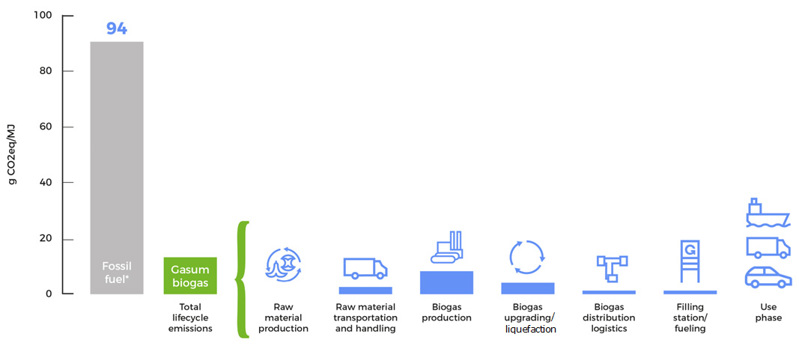Renewable biogas for efficient emission cuts
Biogas is a fully renewable and environmentally friendly fuel that can help to reduce life-cycle greenhouse gas emissions by up to 90% compared with fossil fuel use. Biogas can be used for all the same purposes as natural gas, including as a road and maritime transport fuel and as energy for industry.
Biogas production is part of the circular economy, as biogas is produced from waste feedstocks such as biowaste, sewage sludge, manure and other industrial and agricultural side streams. The organic matter generated as a by-product of biogas is high in nutrient content. These nutrients can be recycled further for use in industry and agriculture.
Biogas use can help to reduce life-cycle emissions by up to 90%
Biogas use can help to reduce greenhouse gas emissions over the entire life cycle (well to wheel, WTW) by up to 90% compared with fossil fuel use. The calculation of the carbon dioxide emission reduction takes into account the entire biogas value chain from biowaste sourcing to biogas production, distribution and use.
Gasum’s greenhouse gas emission calculations are based on the Finnish Energy Authority’s guidelines on sustainability criteria and are in compliance with the EU Renewable Energy Directive (RED II Directive 2018/2001/EU). Gasum’s calculations are verified annually through external and independent third-party audits.
Our carbon dioxide calculations take into account emissions of carbon dioxide (CO2), nitrous oxide (N2O) and methane (CH4). The fossil fuel comparator used is 94 g CO2eq/MJ (RED II Directive).
See the example below for greenhouse gas emissions over the entire life cycle of biogas (well to wheel, WTW) at the various stages of production:

Read more about biogas value chain from feedstock sourcing to distribution and use:
Biogas feedstocks, collection, transport and processing of feedstocks
Feedstocks (raw materials) used in biogas production are delivered to biogas plants from an area within an average of 100 km from the plant. The emissions from feedstock collection and transport are taken into account in the calculations on the basis of fuel consumption and transport distances. In addition to these, emissions taken into account in the calculations are generated at the plant from feedstock processing and odor control.
Biogas production, upgrading and injection into the gas network
As regards biogas production and upgrading, emissions from heat and electricity consumed at biogas plants, emissions from the production of chemicals used in the biogas process and emissions related to water consumption and wastewater treatment are taken into account. Also taken separately into account are emissions from electricity consumption arising from the injection of biogas into the gas network.
Biogas distribution logistics
Emissions related to biogas transmission in the gas pipeline network consist of methane emissions and carbon dioxide emissions from compressor stations and transmission pipelines. Biogas can also be distributed using container transport, which is when transport emissions are taken into account. Electricity is consumed at gas filling stations, and emissions from its production are included in the calculations.
Emissions from biogas use (tank to wheel, TTW)
Just like with other renewable fuels, the calculated level of in-use emissions (tank to wheel, TTW) from renewable biogas in, for example, transport use is regarded to be zero. Biogas combustion generates carbon dioxide, but there is no net increase in atmospheric carbon dioxide because the amount of carbon dioxide fixed in the biodegradable feedstock equals the amount released through biogas combustion.
